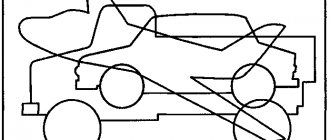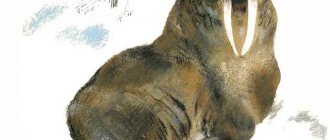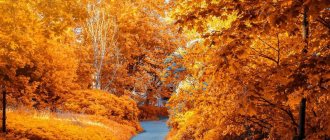ECD for familiarization with the outside world in the senior group “Animals of hot countries”
Svetlana Bylkina
ECD for familiarization with the outside world in the senior group “Animals of hot countries”
Municipal budgetary preschool educational institution – Child Development Center kindergarten No. 5 “Golden Key”
urban district Strezhevoy
Summary of educational activities
around the world
«Animals of hot countries»
Senior group
Bylkina Svetlana Vladimirovna
1. Formation of prerequisites for search activity and intellectual initiative.
Developing the ability to identify possible methods of solving a problem with the help of an adult, and then independently. Forming the ability to apply these methods to help solve a given problem using various options.
2. Form children's ideas about animals .
1. Cultivate a kind attitude towards animals .
2. Develop children's creative abilities in productive activities.
Material: slide presentation, audio recording.
Abstract of the OOD on FCCM “Animals of Hot Countries” in the senior group
Ospischeva Natalya
Abstract of the OOD on FCCM “Animals of Hot Countries” in the senior group
Abstract of the OOD on the FCCM “
Animals of hot countries ” (
senior group ) ORGANIZED EDUCATIONAL ACTIVITIES
(FORMATION OF A COMPLETE PICTURE OF THE WORLD)
TOPIC: "Wild and domestic animals "
Goal: creating a pedagogical situation in the process of activating the socio-emotional experience of children, by expanding their ideas about the world around them ( animals of hot countries )
1) create conditions for children to obtain information about the world around them (wild animals of hot countries )
;
2) cultivate love for the world around us
3) consolidate knowledge about the methods of movement of various animals ;
4) consolidate the ability to jump on one leg at a time;
3) expand your vocabulary;
4) strengthen dramatization skills
1) promote the development of functions of higher nervous activity (attention, thinking, memory)
;
2) continue to introduce sand, the sandbox and the rules of conduct in it;
3) create conditions for the development of impressive and expressive speech;
4) promote the development of coordination of movements, fine and gross motor skills;
5) promote the development of creative imagination;
1) develop children’s respect for each other;
2) form adequate self-esteem and self-criticism, analysis of one’s actions.
3) develop the ability to follow established rules
Familiarization with the rules of behavior in the sandbox
Learning riddles about animals .
Explanation of the meaning of the word "fable"
and reading short fables by I. A. Krylov.
Integration of educational areas:
a) Cognitive development: consolidate the concepts of “wild and domestic animals ”
, introduce the concept of
“
animals of hot countries ” , promote the development of functions of higher nervous activity (attention, thinking, memory, train fine motor skills of the hands.
b) Speech development: develop the ability to participate in dialogue, form the prosodic side of speech.
c) Socio-communicative development: to form in children adequate self-esteem and self-criticism, analysis of their actions, respect for each other, follow basic rules in playing together.
Develop the ability to draw in the sand
e) Physical development: consolidate the ability to jump on one leg in turn.
Equipment: tabletop sandbox, rubber figurines of domestic and wild animals , brush, riddles about wild animals .
Learning physics "Monkey" minutes
Introducing the lexical topic “Wild Animals ”
and
“Pets
” separately .
Explanation of the meaning of the word "fable"
and reading short fables by I. A. Krylov.
Reminder of the rules of sandbox games
Text of the book “Tell children about animals of hot countries”
Victor Moroz Tell children about animals of hot countries
HIPPOPOTAMUS
Thick-skinned, clumsy and huge as a mountain. Loves water, but not puddles, splashing in the river in the morning. He eats the lotus and chews the reeds. A resident of the Nile is a hippopotamus.
Hippos, or hippos as they are also called, live in Africa. They have a thick, clumsy body and a large head. Hippopotamuses weigh up to four tons. The hippopotamus lies in the water for hours, with only its nostrils and eyes exposed.
People have known about the existence of the hippopotamus since ancient times. On the walls of ancient Egyptian temples there are preserved scenes of hunting hippopotamuses, which the Egyptians called “water pigs.” Hippos were brought to ancient Rome to fight in arenas with gladiators.
Hippos seem clumsy and clumsy. On the shore they move slowly, moving their short legs. But as soon as the hippopotamus gets into the water, it immediately transforms! The hippopotamus swims and dives well. Its skin secretes a special reddish liquid, which is why the hippopotamus does not get wet in the water. This liquid is called “bloody sweat” because of its color. In terms of thick skin, the hippopotamus ranks first in the world, surpassing both the rhinoceros and even the elephant!
Hippos live in small herds of 6-15 animals. Hippos are peace-loving creatures and never attack first. But if the boundaries of their territory are violated, they bravely enter into battle even with crocodiles and put them to flight.
Hippopotamus, hippopotamus,
He has a huge mouth, He chews something all day, Apparently not in vain. He is famous in the area. Everyone will say: “It’s a shame Hippopotamus has a wonderful appetite!” Who would risk inviting you to visit? (E. Koryukin)
A newborn hippo rides on its mother's back almost all the time until it grows up.
Poachers hunt hippos, which is why their numbers have declined. Poachers especially value hippopotamus tusks, which do not turn yellow over time, like ivory.
There are also dwarf hippos in Africa. They could not be found in the wild for a long time. Scientists believed that these were tales told by local residents. Only at the beginning of the 20th century was it possible to catch a living pygmy hippopotamus, whose weight was “only” 300 kilograms. These “mini-hippos” feed on roots and tubers of plants.
GIRAFFE
In the heat, having taken off his clothes,
the Giraffe went to the shower. He bent down into a squat, bent and... fell. (Yu. Parfenov)
Giraffes live in Africa - the tallest animals. The height of an adult giraffe reaches 6 meters. The giraffe has a light skin with large brown spots scattered on it. In nature, you cannot find two identically colored giraffes.
Giraffes have smooth fur and a short dark mane growing on their back and neck. Giraffes have horns - up to 5 horns can grow on their heads - more than other mammals.
Giraffes lead a herd lifestyle - 7-12 animals each. The herd is led by the most experienced female. While the others graze, the tall male observes the surrounding area. Acute vision helps him spot danger at a distance of up to one kilometer.
Giraffes are hunted by lions, but they prefer weak or sick animals. And an adult giraffe is capable of fighting back. With a strong hoof he can break a lion's skull.
Grown-up male giraffes engage in fights over females. Such a fight follows strict rules: first, the giraffes walk in a circle, then swing their heads and hit each other in the side and back. When one of the opponents is exhausted, the fight ends.
Giraffes have difficulty eating grass because they have very long necks. To eat grass or drink, the giraffe strongly spreads its front legs to the sides or bends them at the knees.
The main food of these animals is succulent leaves from the branches of tall trees. The giraffe easily reaches the highest branches.
During the day in Africa it is very hot, so giraffes feed only in the morning and evening. And the hot time is spent standing in the shade of trees. At night, giraffes lie on the ground, tucking their front legs and one back leg under them. Giraffes place their head on the second hind leg. Giraffes sleep very lightly and fall into deep sleep for only a few minutes.
MYSTERY
And he walks with his head up,
Not because he is an important count, Not because he has a proud disposition, But because he... (Giraffe)
ZEBRA
The horse's shirt is
striped, like a vest. A horse is a horse, not a sailor. What kind of strangeness is this? Here's the question. (V. Kremnev)
The striped horse - zebra - lives in the African steppes - savannas. All zebras differ from each other in the pattern on their body. Scientists are still arguing about who a zebra is - a white animal with black stripes or a black animal with white stripes?
Striped zebras seem easy to spot in the yellow savannah. But it turns out that when a zebra runs quickly, the flashing stripes seem to merge in the air. At night and in the twilight, when most predators hunt, zebras are completely invisible against the background of bushes.
The zebra has a short mane of coarse hair on its neck, and a black tassel on its tail.
Horses are frolicking on the field.
They play tag and hide and seek. And the zebra stands behind the bushes, embarrassed to go out to them in pajamas. (N. Lamm)
Zebras do not like loneliness and live in large herds of up to 10 thousand animals. Together with African antelopes, zebras feed and go to water. They prefer to eat the very hard and dry upper leaves, while the juicier young shoots are left for the antelopes. When the herd is resting, one of the zebras stands guard, making sure that no predator sneaks up unnoticed.
Zebras run quite fast, they are shy and cautious. But even high speed sometimes does not save them from lions. Other enemies of zebras, especially young foals, are leopards and hyenas. A newborn zebra calf immediately learns to walk - in the savannah it is very important if you want to stay alive to be able to run away from predators.
Although zebras are similar to horses, they always remain wild and are very difficult to tame. In past centuries, zebras were hunted by poachers. The would-be hunters completely exterminated the zebra-like quaggas. Unlike zebras, quaggas only had stripes on their neck and front part of their body.
RHINOCEROS
Rhinoceros is ready to rush into a fight without further ado
. He will not let himself be offended, he is clumsy only in appearance. (V. Stepanov)
One of the largest land animals on Earth is rhinoceroses. Their thick skin is covered with folds and is almost completely hairless. On the head of a rhinoceros there are one or two curved or straight horns.
In the Middle Ages, European scientists did not see a living rhinoceros, they only heard stories about it from travelers who visited Africa. This is how legends about magical unicorns appeared. The artist Albrecht Durer painted a rhinoceros covered with scales and a thick shell.
There are a lot of horned dogs
in the zoo and in the forest, They all have horns on their heads, but he only has horns on his nose.
Rhinoceros horn was believed to have magical properties. A cure for all diseases was allegedly obtained from it, and the poisoned drink poured into the horn began to boil. Rhino horns were very expensive, and many poachers went to hunt rhinos. As a result, a significant number of rhinoceroses were destroyed. There are very few rhinoceroses left today. They live mainly in nature reserves and protected national parks.
Despite the fact that the rhinoceros is very strong, it is surprisingly clumsy. You can easily escape from a rhinoceros by simply turning to the side.
The aggressiveness of the rhinoceros can be explained simply - it has poor eyesight. Therefore, the rhinoceros rushes at any object unfamiliar to it, sometimes even a tree. Running closer, he sees that there is no danger for him and calms down.
The largest rhinoceroses are African ones. The skin of black and white rhinos is devoid of folds. The length of the front horn reaches 70–80 cm. Adult male white rhinoceros weigh up to 5 tons. Rhinoceroses can run very fast, although only for short distances. If the rhinoceros is calm, then it walks with its head down, and raises its head when it inspects the area or gets angry.
Rhinoceroses living in Asia are smaller than their African counterparts. There are very few of them left, so hunting them is prohibited.
Ten thousand years ago, when there was an ice age on our planet, the ancestors of rhinoceroses, woolly rhinoceroses, lived in the cold tundras of Northern Eurasia and the steppes of North Africa. They were larger in size than their modern descendants, and their bodies were covered with thick fur.
HYENA
We asked the hyena
what hygiene is. And she answered: “I’m strong in this matter, I brush my teeth in the morning, I remove all trash!” (V. Moroz)
Although hyenas are similar to dogs, their closest relatives are mongooses. The largest hyena, the spotted hyena, lives in Africa.
Many people think that hyenas are cowardly and stupid animals that feed on carrion and harm agriculture. This is not entirely true. Hyenas are smart and brave creatures. By eating dead or sick animals, they play the role of scavengers, waste collectors.
Sometimes hyenas also hunt small antelopes and attack livestock. If they get angry, they can even attack a person. At the same time, a smart hyena will not attack a hunter who has a firearm in his hands. She sees that she is facing a serious opponent and retreats.
Hyenas have very strong and large teeth. They are capable of grinding even large bones.
Spotted hyenas hunt wildebeest. Usually at night, but sometimes without waiting for darkness to set in, several hyenas attack a weakened animal or cub that has strayed from the herd. They can persistently chase their prey for many kilometers, while almost never getting tired.
Hyenas have no friends; all predators are at enmity with them. Hyenas make a living by taking prey from leopards or cheetahs. Leopards, in order to save the caught animal, drag it into a tree where hyenas cannot climb.
Many hyenas live near lions and feed on the remains of their prey. Sometimes the opposite happens - an adult lion takes a dead antelope from successful hyena hunters. But woe to a weak or aged lion - he becomes a victim of younger and stronger hyenas.
CHEETAH
The cheetah's success lies in the fact
that it runs the fastest. And the success of the snail is that
it
carries its own home. (Yu. Parfenov)
Very unusual animals are cheetahs. Although they belong to the cat family, they have many characteristics of other predators. Cheetahs cannot retract their claws like all cats do. In appearance, cheetahs are more similar to greyhounds - they have a long, graceful body, and short yellow fur covered with black spots. This coloring helps them hide in the grass.
Cheetahs are the fastest runners on Earth. When chasing prey, they can reach speeds of up to 120 kilometers per hour. Their body is ideally suited for fast running. The head is small and round in shape. The legs are long with well-developed muscles. The fluffy tail serves as a balancer while running, helping to maintain balance.
Cheetahs quietly, hiding in the grass, sneak up on grazing antelopes. Coming closer, they rush to attack. If a cheetah fails to immediately catch up with its prey, it stops pursuing because it cannot run for a long time at great speed. To restore its breathing after a short run, the cheetah rests for about half an hour, then continues hunting again.
Cheetahs usually hunt alone, but sometimes they join in pairs or small groups.
Three thousand years ago, the ancient Egyptians tamed cheetahs and took them with them to hunt. Scientists have found images of hunting cheetahs in Egyptian pyramids.
Cheetahs once lived in Africa and the Asian steppes. Asiatic cheetahs have a small mane growing on their neck and upper back. Today, cheetahs remain only in East and South-West Africa, although there are reports of eyewitnesses who have seen cheetahs in remote areas of Central Asia and India.
Cheetahs are easily tamed and tolerate captivity well. Although there are many of them in zoos around the world, they very rarely give birth to young in captivity. Newborn kittens have gray-blue fur, which has no spots at all, and a fluffy mane on their necks.
A LION
A formidable lion with a huge mane
drinks water leisurely. The maned lion is the king of beasts, There is no braver beast in the jungle. (V. Stepanov)
It is not for nothing that Leo is called the king of beasts. An adult male is a huge, majestic animal with a powerful, muscular body. His large eyes seem to radiate wisdom, and his head is framed by a thick, lush mane. Lioness do not have such a lush mane as males. A lion can make a very loud roar, letting the animals around know that this is his territory.
In Ancient Egypt, the lion was a symbol of divine and royal power; among the ancient Assyrians and Greeks, lions accompanied the gods. The image of lions adorns the coats of arms of many states.
Lions live in large families called prides. Usually a pride has one male, several females and cubs. The family protects and takes care of their babies, but no one needs old and sick lions. They are expelled from the pride, and they become easy prey for hyenas.
Young lions, when they grow up, leave the pride and go on an independent journey across the savannah. Having met a flock of several females, they organize their own pride. It happens that a young lion captures someone else's pride, expelling the weakened and aged leader.
Lions have a clear division of responsibilities - males protect the territory, and females hunt. Adult lions need to eat about 18 kilograms of meat per day, so lionesses are forced to hunt a lot. They sit patiently in ambush and then attack their prey - a gazelle or antelope. The lioness jumps on the antelope's back and sinks her fangs into its neck.
The male is the first to approach the caught prey. He can eat as much as he wants - “the lion's share”, often leaving very little food for the females and cubs.
MYSTERY
A menacing roar suddenly rang out,
scaring away all the birds around. , in short... (Lion)
GORILLA
Gorilla is the largest ape. The height of adult males reaches two meters, and their weight is more than 300 kilograms. Gorillas have a large head with a low forehead and very long forelimbs - gorillas rely on them when moving.
Gorillas live in the tropical forests and mountains of Equatorial Africa. Despite their rather ferocious appearance, these huge monkeys feed mainly on plant foods. They eat not only fruits, berries and nuts, but also do not disdain roots, plant stems, even tree bark, which they chew with their strong, strong teeth.
European scientists first learned about gorillas at the end of the 16th century. The English sailor Andrew Batt, who lived in captivity in Africa for several years, spoke about huge black monkeys.
Mountain gorillas, which live on the slopes of extinct volcanoes in East Africa, were discovered in the early 20th century. These are very rare animals. Currently, there are very few of them left in the wild.
Gorillas live in family groups, which are led by an adult male who has reached the age of 10 years. Gray hair appears on the back of the leader, while young males are completely black.
In a herd, everyone obeys the leader. He chooses places for feeding and sleeping. Having found a secluded corner, gorillas tilt the trunks of young trees to the ground and throw leaves on them - they make a soft rookery.
Mom, the wise gorilla, once told her son “Fear the rain, under a wide leaf, son.” But hold it skillfully in your hand - it will be your umbrella. (S. Chertkov)
Gorillas are peaceful animals. Despite their enormous physical strength, they almost never fight with each other. Even if there is a dispute between two males, the matter never ends in “assault”. Males defeat each other by the power of their gaze - they gaze intently into the eyes of the enemy. The one who cannot stand the gaze and moves aside is the one who lost.
MYSTERY
Oh look, man!
And on the body there is black fur. We made a mistake, looks cute from the bushes at us... (Gorilla)
ELEPHANT
An elephant weighs
three hundred tons: A ton is an ear, A ton is a leg, Just like that baby! (G. Tsyferov)
Elephants are the largest land animals. Today, there are two species of elephants living on Earth: African and Indian. Male African elephants weigh up to seven tons. The Indian elephant is slightly smaller.
The elephant has a wonderful trunk:
It tears bananas from palm trees, It pours water like from a shower, It sings trumpet songs. (N. Migunova)
The upper lip and nose of elephants seem to have grown together, forming a movable organ - the trunk. At the end of the trunk there are nostrils and “fingers” - sensitive processes with which the elephant can pick up even small objects, such as coins or nails, from the ground. The elephant uses its trunk to bring food to its mouth, draw water into it, and then pour it into its mouth. The trunk is very important for an elephant; if it is cut off, the elephant will die from exhaustion.
In addition to the unusual nose-trunk, elephants have unusual teeth - tusks, into which the incisors of the upper jaw have turned. The tusks serve both for obtaining food and for protection from enemies. Male African elephants have especially large tusks - their length is over three meters. Tusks are highly valued, which is why elephants are hunted by poachers.
Large ears protect elephants from overheating. Indian elephants have smaller ears than African elephants. Elephants have thick and wrinkled skin.
The elephant laughs
in the heat of the day: “The glorious shower is always with me!”
Elephants feed on tree branches, leaves, grass, roots, and fruits. One elephant eats up to 150 kilograms of green food per day.
Elephants live in herds, only older males live alone. The herd usually contains from 5 to 20 animals. A wise old elephant becomes the leader of the herd. Little elephant calves need not be afraid of predators - the entire herd comes to their protection.
People have domesticated Indian elephants. They often live near villages. Elephants are used in logging work; they can easily carry large logs or lift other heavy objects.
Elephants live 60–70 years. The female carries the cub for almost two years. A newborn elephant weighs 100 kilograms. For two years of life, the elephant calf feeds on its mother’s milk, and becomes independent only at the age of five.
PANGOLIN
The cunning lizard pangolin
surprised Leopard - He bent in an arc, curled up in front of him. The leopard, no matter how hard he tried, did not reach the pangolin. (V. Moroz)
Deep burrows can often be found in Equatorial and Southern Africa. They were dug by strange creatures - pangolins. The body of pangolins is similar in color and shape to a fir cone - it is covered with large overlapping horny scales. For this cover, similar to the scales of reptiles, these animals are also called lizards.
The areas of the body that are free from scales - the muzzle, belly, lower body and inner surface of the legs - are covered with short, stiff hair. Pangolins have no teeth, but they have a long (up to 25 cm), thin and sticky tongue. With its help, the pangolin removes termites and ants from nests. Pangolins hide in burrows, hollows or treetops during the day, and go out hunting at night. With strong paws, which are armed with sharp long claws, they break apart termite mounds and anthills.
Some species of lizards can run quickly and deftly climb trees.
If the pangolin is in danger, it curls up into a ball. Only very strong animals, such as a lion or leopard, can turn a pangolin around.
African tribes came up with many legends about lizards. Representatives of the Bantu tribe believe that a rainbow is hidden in the termite mound. The pangolin, tearing apart the termite mound, releases the rainbow into the wild, and thus ends the rainy season. According to another belief, if you jump through a hole made by a pangolin in a termite mound, you will have good luck.
Baby pangolins are born without scales and live in burrows until they grow up. He travels sitting on his mother's tail.
KANGAROO
The mother kangaroo carries
the Baby in her pocket. It’s good for the kangaroo and comfortable for the mother. (N. Migunova)
Marsupial mammals live only in Australia and America. They were named so because they carry their newborn babies in a pouch. The kangaroo is the largest marsupial and a symbol of Australia.
The origin of the name of this beast is funny. When English sailors under the command of Captain James Cook first landed on the Australian coast, they saw strange animals that jumped along the shore like huge grasshoppers. "Who is this?" - the British asked the local residents - the aborigines. They shook their heads and answered: “Ken-gu-ru,” which meant: “I don’t understand.” This is how the unusual name was retained for the kangaroo.
The largest of the marsupials is the red kangaroo: its body length reaches 160 centimeters and its weight is 80 kilograms. Smaller ones are gray kangaroos and wallabies.
Kangaroos move by jumping on long and strong legs. The thick and powerful tail serves as a support when the kangaroo sits and as a balance when it jumps. A kangaroo can jump 13 meters in length and 3.5 meters in height.
The front legs of a kangaroo are very short. Animals use them to hold food and bring it to their mouth. Sometimes they rely on them when jumping.
Kangaroos are peaceful herbivores. They gather in large flocks that number several hundred kangaroos.
The kangaroo jumps quickly
, both in the cool and in the heat, He carries a bag with him, His baby lives in it! The bag is soft and warm, There the baby drinks milk, And the Australian kangaroo is like a jumper! (M. Lvovsky)
A kangaroo gives birth to one baby, no larger than a walnut. He crawls along his mother's belly and into her pouch. He lives there for about six months, eating only milk. Grown-up kangaroos get out of the pouch and travel with their mother. But in case of danger, they can jump back into the bag.
True, kangaroos in Australia have almost no enemies. With a blow from a strong leg, they can throw back both a dog and even a person. And they gallop at such a speed that even in a car it can be difficult to catch up with them.






